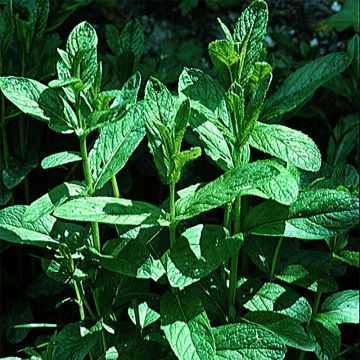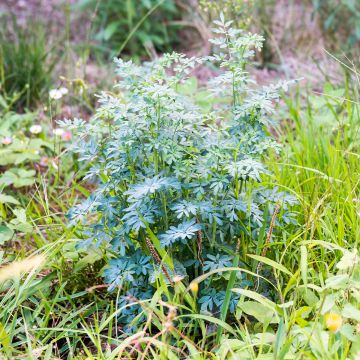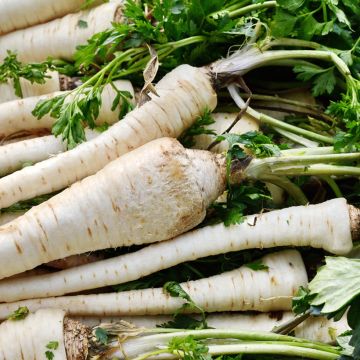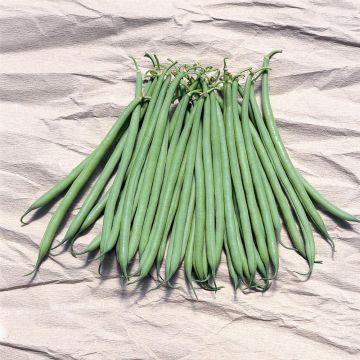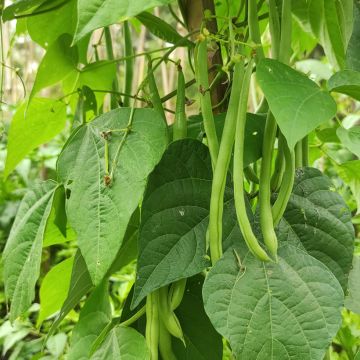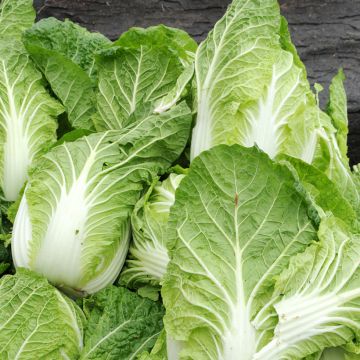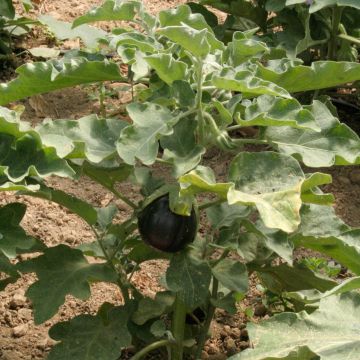

Aromates en mélange (Ciboulette commune - Persil Frisé Vert Foncé - Basilic Simple Grand Vert - Cerfeuil commun simple) AB - Ferme de Ste Marthe
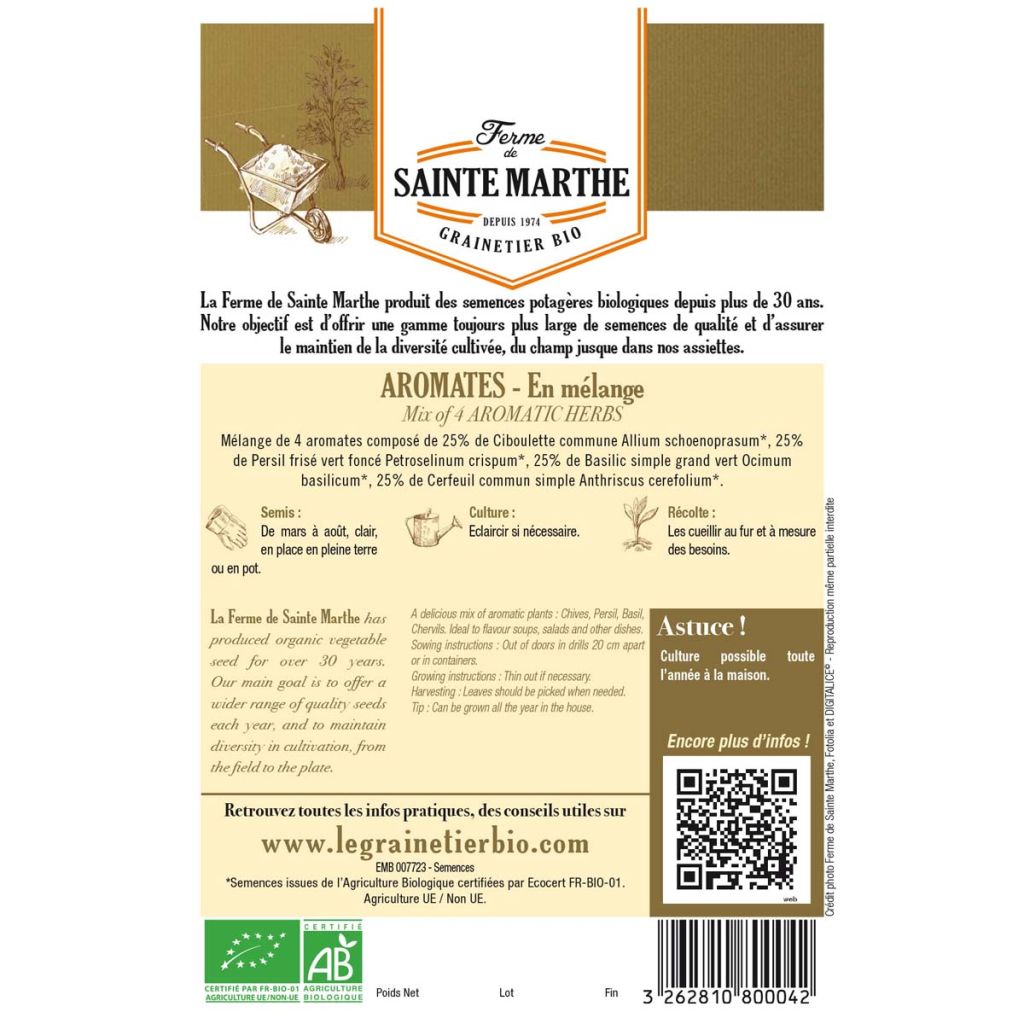

Aromates en mélange (Ciboulette commune - Persil Frisé Vert Foncé - Basilic Simple Grand Vert - Cerfeuil commun simple) AB - Ferme de Ste Marthe
Herbs mix - chives, parsley, coriander, chervil
Allium, Petroselinum, Coriandrum, Anthriscus schoenoprasum, crispum, sativum, cerefolium
Upon receipt, I separated the seeds, very few chive seeds in the packet, only two parsley plants have sprouted.
Marinette, 07/09/2022
This item cannot be shipped to the selected country
Dispatch by letter from €3.90
More information
Schedule delivery date,
and select date in basket
This plant carries a 6 months recovery warranty
More information
We guarantee the quality of our plants for a full growing cycle, and will replace at our expense any plant that fails to recover under normal climatic and planting conditions.
Seed-only orders are dispatched by sealed envelope. The delivery charge for seed-only orders is €3.90.
Description
The Herb Mix is a very rich blend composed of Common Chives, Common Parsley 2, Coriander, Common Chervil). These aromatic and condimental plants are cultivated for their foliage with different scents that will be used in the preparation of various hot or cold dishes. Sowing period from March to August for a harvest 2 months later.
The Chives, also known as Civette or Appétits, is a tasty perennial aromatic plant. It is one of the most popular herbs. It belongs to the same family as garlic, onion and shallot. It has a tufted habit and thin hollow cylindrical leaves. It is a perennial plant that will be cultivated for two or three years because beyond that, it tends to exhaust itself and become less productive. It will then need to be divided.
The fresh, garlic-like and slightly spicy taste of its leaves suits many dishes: omelette, stuffings, savory pies and seasoning for fresh cheeses... It is a must-have in herb gardens but there is nothing stopping you from mixing styles and planting it everywhere in the garden, especially at the base of roses: its flowering in pinkish-purple pompoms is charming and its aromas repel aphids and prevent black spot disease. It is therefore also a first-class companion plant.
Originally from the Middle East, Common Chervil is cultivated for its appetizing, purifying, diuretic and stimulating properties. It contains vitamin C as well as trace elements. In cooking, the fresh leaves, finely chopped, flavor raw vegetables, salads, soups, many vegetables, sauces, stews, roasted meats, grilled dishes and certain fishes.
Parsley is an aromatic herb, also used as a medicinal plant. It is rich in vitamins, trace elements and minerals. Its very high content of vitamins C and A should be noted: 100 g of parsley contains four times more vitamin C than 100 g of an orange and four times the daily requirement of vitamin A. It is a stimulant for the nervous system, it effectively fights anemia and has detoxifying properties.
It is therefore not surprising that it symbolized strength in ancient Greece and was adored by the Romans who introduced it to many countries in the Empire. It fell out of favor in the Middle Ages where it was associated with the devil. The explanation probably lies in the somewhat unpredictable germination of the plant. This biennial plant native to the Near East is cultivated as an annual except if you want it to go to seed and harvest the seeds. It then produces umbels of tiny greenish-yellow to white flowers. But it is for its leaves that parsley is cultivated. It contains essential oils and emits a fragrant scent when crushed. They are bright green, divided into three leaflets and deeply lobed. Parsley is sometimes confused with small hemlock - a toxic plant - whose leaves are similar but which gives off a nauseating smell. Tuberous parsley is cultivated for both its taproot and foliage. Parsley plants can reach a height of 60 cm (24in).
It is often included in bouquet garni along with thyme, bay leaf and rosemary. It is highly appreciated in persillades that accompany green beans, snails, etc. It is also frequently used as a decorative element on dishes.
This blend of herbs will require a supply of well-decomposed compost (3 kg/m²) in late autumn or early spring.
Harvest: Between April and October, it is harvested as needed and as it develops.
Storage: Between April and October, this blend can be stored for a few days in a glass filled with water.
Gardener's tip: Regular weeding and hoeing should be done. Pinch the flowering stems so that new branches develop. The smell of its leaves repels mosquitoes.
Report an error about the product description
Harvest
Plant habit
Foliage
Botanical data
Allium, Petroselinum, Coriandrum, Anthriscus
schoenoprasum, crispum, sativum, cerefolium
Alliaceae, Apiaceae, Apiaceae, Apiaceae
Cultivar or hybrid
Annual
Other Herb seeds
Planting and care
Direct sowing
The seeds are preferably sown from March to April. Space the rows 40 cm (16in) apart. In well-prepared soil, make a furrow 1 cm (0in) deep and place the seeds. Cover the seeds with 1 cm (0in) of fine soil or compost, then firm with the back of the rake. Water
When the young plants have 4 to 5 leaves, thin them to 15 cm (6in) apart in the row.
Maintenance
Using mulch around the base of your plants helps maintain some moisture and reduces the need for weeding. The plants do not require much watering, as their root system reaches deep to find available resources. Water generously only during prolonged drought.
Seedlings
Care
Intended location
-
, onOrder confirmed
Reply from on Promesse de fleurs
Vegetable seeds
Haven't found what you were looking for?
Hardiness is the lowest winter temperature a plant can endure without suffering serious damage or even dying. However, hardiness is affected by location (a sheltered area, such as a patio), protection (winter cover) and soil type (hardiness is improved by well-drained soil).

Photo Sharing Terms & Conditions
In order to encourage gardeners to interact and share their experiences, Promesse de fleurs offers various media enabling content to be uploaded onto its Site - in particular via the ‘Photo sharing’ module.
The User agrees to refrain from:
- Posting any content that is illegal, prejudicial, insulting, racist, inciteful to hatred, revisionist, contrary to public decency, that infringes on privacy or on the privacy rights of third parties, in particular the publicity rights of persons and goods, intellectual property rights, or the right to privacy.
- Submitting content on behalf of a third party;
- Impersonate the identity of a third party and/or publish any personal information about a third party;
In general, the User undertakes to refrain from any unethical behaviour.
All Content (in particular text, comments, files, images, photos, videos, creative works, etc.), which may be subject to property or intellectual property rights, image or other private rights, shall remain the property of the User, subject to the limited rights granted by the terms of the licence granted by Promesse de fleurs as stated below. Users are at liberty to publish or not to publish such Content on the Site, notably via the ‘Photo Sharing’ facility, and accept that this Content shall be made public and freely accessible, notably on the Internet.
Users further acknowledge, undertake to have ,and guarantee that they hold all necessary rights and permissions to publish such material on the Site, in particular with regard to the legislation in force pertaining to any privacy, property, intellectual property, image, or contractual rights, or rights of any other nature. By publishing such Content on the Site, Users acknowledge accepting full liability as publishers of the Content within the meaning of the law, and grant Promesse de fleurs, free of charge, an inclusive, worldwide licence for the said Content for the entire duration of its publication, including all reproduction, representation, up/downloading, displaying, performing, transmission, and storage rights.
Users also grant permission for their name to be linked to the Content and accept that this link may not always be made available.
By engaging in posting material, Users consent to their Content becoming automatically accessible on the Internet, in particular on other sites and/or blogs and/or web pages of the Promesse de fleurs site, including in particular social pages and the Promesse de fleurs catalogue.
Users may secure the removal of entrusted content free of charge by issuing a simple request via our contact form.
The flowering period indicated on our website applies to countries and regions located in USDA zone 8 (France, the United Kingdom, Ireland, the Netherlands, etc.)
It will vary according to where you live:
- In zones 9 to 10 (Italy, Spain, Greece, etc.), flowering will occur about 2 to 4 weeks earlier.
- In zones 6 to 7 (Germany, Poland, Slovenia, and lower mountainous regions), flowering will be delayed by 2 to 3 weeks.
- In zone 5 (Central Europe, Scandinavia), blooming will be delayed by 3 to 5 weeks.
In temperate climates, pruning of spring-flowering shrubs (forsythia, spireas, etc.) should be done just after flowering.
Pruning of summer-flowering shrubs (Indian Lilac, Perovskia, etc.) can be done in winter or spring.
In cold regions as well as with frost-sensitive plants, avoid pruning too early when severe frosts may still occur.
The planting period indicated on our website applies to countries and regions located in USDA zone 8 (France, United Kingdom, Ireland, Netherlands).
It will vary according to where you live:
- In Mediterranean zones (Marseille, Madrid, Milan, etc.), autumn and winter are the best planting periods.
- In continental zones (Strasbourg, Munich, Vienna, etc.), delay planting by 2 to 3 weeks in spring and bring it forward by 2 to 4 weeks in autumn.
- In mountainous regions (the Alps, Pyrenees, Carpathians, etc.), it is best to plant in late spring (May-June) or late summer (August-September).
The harvesting period indicated on our website applies to countries and regions in USDA zone 8 (France, England, Ireland, the Netherlands).
In colder areas (Scandinavia, Poland, Austria...) fruit and vegetable harvests are likely to be delayed by 3-4 weeks.
In warmer areas (Italy, Spain, Greece, etc.), harvesting will probably take place earlier, depending on weather conditions.
The sowing periods indicated on our website apply to countries and regions within USDA Zone 8 (France, UK, Ireland, Netherlands).
In colder areas (Scandinavia, Poland, Austria...), delay any outdoor sowing by 3-4 weeks, or sow under glass.
In warmer climes (Italy, Spain, Greece, etc.), bring outdoor sowing forward by a few weeks.

































